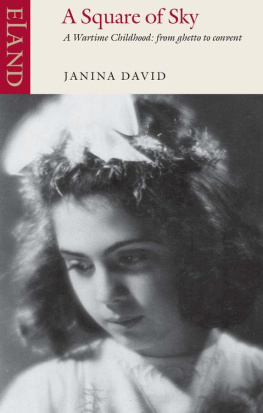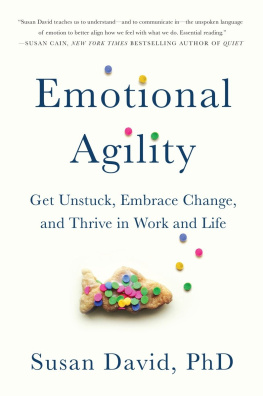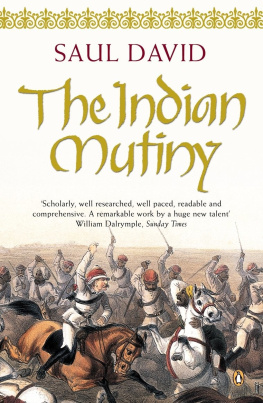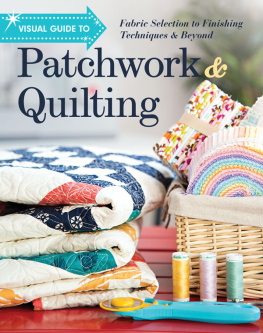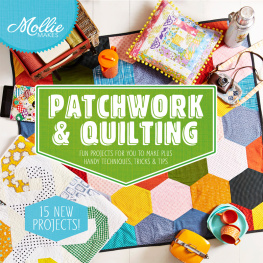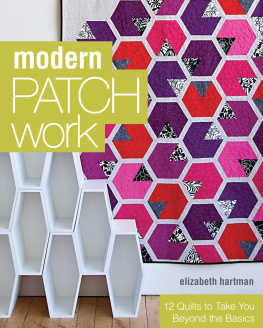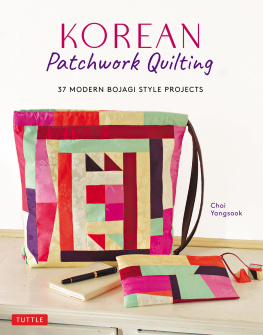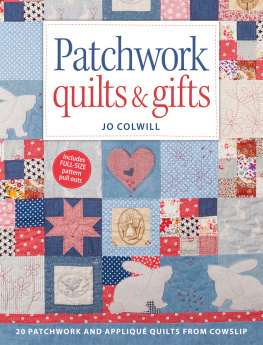David - How to Sew--Patchwork
Here you can read online David - How to Sew--Patchwork full text of the book (entire story) in english for free. Download pdf and epub, get meaning, cover and reviews about this ebook. year: 2010, publisher: F+W Media, genre: Home and family. Description of the work, (preface) as well as reviews are available. Best literature library LitArk.com created for fans of good reading and offers a wide selection of genres:
Romance novel
Science fiction
Adventure
Detective
Science
History
Home and family
Prose
Art
Politics
Computer
Non-fiction
Religion
Business
Children
Humor
Choose a favorite category and find really read worthwhile books. Enjoy immersion in the world of imagination, feel the emotions of the characters or learn something new for yourself, make an fascinating discovery.
- Book:How to Sew--Patchwork
- Author:
- Publisher:F+W Media
- Genre:
- Year:2010
- Rating:4 / 5
- Favourites:Add to favourites
- Your mark:
- 80
- 1
- 2
- 3
- 4
- 5
How to Sew--Patchwork: summary, description and annotation
We offer to read an annotation, description, summary or preface (depends on what the author of the book "How to Sew--Patchwork" wrote himself). If you haven't found the necessary information about the book — write in the comments, we will try to find it.
Proving that you dont need to be an expert to create beautiful pieces of quilted patchwork, this little guide covers all the basic techniques you will need to start your own projects however ambitious they are!
How to Sew--Patchwork — read online for free the complete book (whole text) full work
Below is the text of the book, divided by pages. System saving the place of the last page read, allows you to conveniently read the book "How to Sew--Patchwork" online for free, without having to search again every time where you left off. Put a bookmark, and you can go to the page where you finished reading at any time.
Font size:
Interval:
Bookmark:

How to Sew:
Patchwork

A DAVID & CHARLES BOOK
Copyright David & Charles Limited 2009, 2010
David & Charles is an F+W Media Inc. company
4700 East Galbraith Road
Cincinnati, OH 45236
First published in the UK in 2009
This digital edition published in 2010
Text, illustrations and photography copyright David & Charles Limited 2009, 2010
Project designs copyright Susan Briscoe, Alice Butcher & Ginny Farquhar, Lynne Edwards, Marion Elliot, Christina Marsh, Ellen Kharade, Sally Southern, Jo Verso and Dorothy Wood 2009, 2010
Susan Briscoe, Alice Butcher & Ginny Farquhar, Lynne Edwards, Marion Elliot, Christina Marsh, Ellen Kharade, Sally Southern, Jo Verso and Dorothy Wood have asserted their right to be identified as authors of this work in accordance with the Copyright, Designs and Patents Act, 1988.
All rights reserved. No part of this publication may be reproduced, stored in a retrieval system, or transmitted, in any form or by any means, electronic or mechanical, by photocopying, recording or otherwise, without prior permission in writing from the publisher.
The designs in this book are copyright and must not be made for resale.
The author and publisher have made every effort to ensure that all the instructions in the book are accurate and safe, and therefore cannot accept liability for any resulting injury, damage or loss to persons or property, however it may arise.
Names of manufacturers, paper ranges and other products are provided for the information of readers, with no intention to infringe copyright or trademarks.
A catalogue record for this book is available from the British Library.
ISBN-13: 978-0-7153-3884-1 epub
ISBN-10: 0-7153-3884-6 epub
ISBN-13: 978-0-7153-3894-0 pdf
ISBN-10: 0-7153-3894-3 pdf
David & Charles publish high quality books on a wide range of subjects. For more great book ideas visit: www.rucraft.co.uk
For templates please see end of book or download them free at: www.rucraft.co.uk/how_to_sew_templates.php
Patchwork and quilting is a deeply satisfying craft, comprising of three stages. Firstly, you need an idea for your patchwork, then you need to choose the fabrics, cut them to size and piece the fabric blocks together, either by hand or with a machine. Finally comes the quilting and finishing to turn your fabric blocks into a quilted masterpiece.
Before cutting your fabrics, prepare them by washing them before use in mild detergent, in case any colours run and to allow for shrinkage. To cut your fabrics, you will need a ruler, cutting mat and rotary cutter.

Start with the ruler firmly on top of your fabric, squaring off uneven ends of the fabric and cutting off the tightly woven selvedge. Cut with the grain of the fabric (with printed stripes and checks, cut with the pattern).
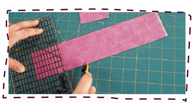
Turn your cutting mat through 180 degrees and line up the relevant mark on the ruler for example, 6.5cm (2in) if 5cm (2in) is the finished size. Line up your rotary cutter against the ruler's edge and cut.

When working on piecing your patchwork, press each stage as you go along, with the seam allowance to one side as later this will help stop the wadding (batting) from coming through the seam. Press from the front of the work with a dry iron or just a little steam, using an up and down action so the patchwork is not stretched and distorted.
Once cut to size, your fabric blocks can be pieced together either by hand piecing or using a sewing machine. It is important to bear seam allowances in mind. When you cut templates for machine piecing, you should include seam allowances, as the width of the sewing machine will automatically allow 0.5cm (in) between the cut edge and your sewing line. For hand piecing, the seam allowances should not be included.
Machine piecing is perfect for quilts that need to be durable or need to be made more quickly than normal.

Place your first two pieces right sides together, making sure the edges to be sewn line up. Set your sewing machine to a slightly shorter than average stitch length and make sure that the tension is even.

Use the quarter-inch foot and line up the fabric edge with the edge of the foot when you sew. Some quarter-inch feet have a guide plate on the right-hand side so the fabric can't be sewn with a wider seam.
Cut about 45cm (18in) of thread and tie a knot in the end. Hold your pinned pieces firmly in one hand and remove the first pin.
Bring the needle in from the back of the fabric, 3mm (1/8in) from the corner. Take a backstitch to the corner, making sure your stitches are on the marked line.
Sew along the line, inserting the odd backstitch and removing the pins as you go.
At the end, sew another backstitch, but insert the needle through the loop as you form the last stitch, to secure.
This technique can speed up piecing patchwork made from squares and rectangles. It must be machine sewn because the seams are cut across and hand sewing would come undone.

Cut rotary strips to the required width and sew them together, first as pairs, then sew the pairs together until the panel is complete this stops the strips creeping out of alignment. Press the seams to one side.

Rotary cut further units across the sewn seam, remembering the seam allowance, then rearrange and sew together.
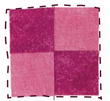
For a 10cm (4in) four-patch block, you would cut strips and then the units 6.5cm (2in) wide.
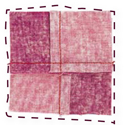
The finished block would still have a 6mm (in) seam allowance all round, measuring 11.5cm (4in).
This speed piecing machine technique allows you to make triangle square elements in a block without sewing on a cut bias edge, which may distort and spoil your patchwork.
Font size:
Interval:
Bookmark:
Similar books «How to Sew--Patchwork»
Look at similar books to How to Sew--Patchwork. We have selected literature similar in name and meaning in the hope of providing readers with more options to find new, interesting, not yet read works.
Discussion, reviews of the book How to Sew--Patchwork and just readers' own opinions. Leave your comments, write what you think about the work, its meaning or the main characters. Specify what exactly you liked and what you didn't like, and why you think so.




